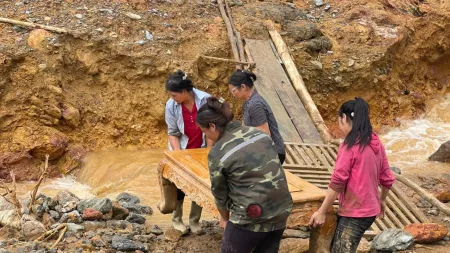Typhoon Yagi, the strongest storm to hit Asia this year, has unleashed destruction across Southeast Asia, affecting over 20 million people in Vietnam, the Philippines, Laos, Thailand, and Myanmar. Severe flooding and landslides have already resulted in nearly 200 casualties and displaced hundreds of thousands, with numbers expected to rise as heavy rains persist and the risk of further flooding remains high.
"This is the strongest typhoon we’ve seen in 30 years.”Dung Le Kim, CARE Vietnam Director
Typhoon Yagi has ravaged 26 provinces in Vietnam, affecting nearly 19 million people. Flash floods and landslides have left nearly 300 casualties or missing, while over 101,000 homes and 200,000 hectares of farmland have been destroyed, severely threatening food security. Key industrial hubs have also been damaged, with flooding in factories and warehouses disrupting Vietnam’s economy and global supply chains. “Entire communities in northern Vietnam are in shock after the storm wiped out homes and livelihoods. This is the strongest typhoon we’ve seen in 30 years,” said Dung Le Kim, CARE Vietnam Director. “In the mountainous areas in the North, hundred thousand have been displaced and evacuated. The damage is overwhelming, and the recovery process will be long.” CARE Vietnam is on the ground, coordinating with government partners to assess the hardest-hit areas and deliver recovery support.
“Southeast Asia is on the frontline of the global climate crisis, facing relentless storms, rising sea levels, and worsening floods year after year."Ramesh Singh, CARE Asia Regional Director
“Typhoon Yagi has left millions of lives in ruins across Southeast Asia, with entire communities overwhelmed as the region grapples with increasingly intense and frequent typhoons,” said Ramesh Singh, CARE Asia Regional Director. “Southeast Asia is on the frontline of the global climate crisis, facing relentless storms, rising sea levels, and worsening floods year after year. Our primary concern is for women and girls, who are often the most vulnerable during and after crises, facing unique challenges in accessing safety, healthcare, and economic support. A coordinated effort is needed to tackle the climate crisis and ensure that the most vulnerable, including women and girls, are protected and supported.”
"Our primary concern is for women and girls, who are often the most vulnerable during and after crises,"Ramesh Singh, CARE Asia Regional Director
While Vietnam has faced the worst of Yagi’s destruction, the storm has also heavily impacted other parts of Southeast Asia. The Philippines, still recovering from Typhoon Gaemi just two months ago, was further battered by Yagi, affecting 1.6 million people. As typhoons become more frequent and intense, recovery efforts in the country have become increasingly challenging. In Laos, Yagi's heavy rains forced hydropower plants to release water, triggering severe floods across northern provinces, with over 32,000 people affected and widespread damage to schools, temples, homes, hospitals, and farms. The Mekong River remains at dangerously high levels, especially near Luang Prabang and Vientiane. Northern Thailand and parts of Myanmar have also been hit hard, with severe floods isolating villages and affecting thousands. With more heavy rain forecast, the risk of further flooding remains critical.
For media inquiries, please contact:
Sarita Suwannarat, Asia Regional Communications Advisor
Email: [email protected]
